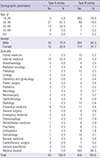1. Yoon J, Oh IH, Seo H, Kim EJ, Gong YH, Ock M, Lim D, Lee WK, Lee YR, Kim D, et al. Disability-adjusted Life Years for 313 Diseases and Injuries: the 2012 Korean Burden of Disease Study. J Korean Med Sci. 2016; 31:Suppl 2. S146–S157.
2. Salomon JA, Mathers CD, Chatterji S, Sadana R, Ustun TB, Murray CJ. Quantifying individual levels of health: definitions, concepts and measurement issues. In : Murray CJ, Evans DB, editors. Health Systems Performance Assessment: Debate, Methods, and Empiricism. Geneva: World Health Organization;2003. p. 301–318.
3. Lee YH, Yoon SJ, Kim A, Seo H, Ko S. Health Performance and Challenges in Korea: a Review of the Global Burden of Disease Study 2013. J Korean Med Sci. 2016; 31:Suppl 2. S114–S120.
4. Salomon JA, Vos T, Hogan DR, Gagnon M, Naghavi M, Mokdad A, Begum N, Shah R, Karyana M, Kosen S, et al. Common values in assessing health outcomes from disease and injury: disability weights measurement study for the global burden of disease study 2010. Lancet. 2012; 380:2129–2143.
5. Murray CJ, Lopez AD. The Global Burden of Disease: a Comprehensive Assessment of Mortality and Disability from Diseases, Injuries, and Risk Factors in 1990 and Projected to 2020. Cambridge, MA: Harvard University Press;1996.
6. Stouthard ME, Essink-Bot ML, Bonsel GJ, Barendregt JJ, Kramers P, van de Water HP, Gunning-Schepers LJ, van der Maas PJ. Disability Weights for Diseases in the Netherlands. Rotterdam: Erasmus University;1997.
7. Stouthard ME, Essink-Bot ML, Bonsel GJ. Disability weights for diseases. A modified protocol and results for a Western European region. Eur J Public Health. 2000; 10:24–30.
8. Ustün TB, Rehm J, Chatterji S, Saxena S, Trotter R, Room R, Bickenbach J; WHO/NIH Joint Project CAR Study Group. Multiple-informant ranking of the disabling effects of different health conditions in 14 countries. Lancet. 1999; 354:111–115.
9. Salomon JA, Haagsma JA, Davis A, de Noordhout CM, Polinder S, Havelaar AH, Cassini A, Devleesschauwer B, Kretzschmar M, Speybroeck N, et al. Disability weights for the global burden of disease 2013 study. Lancet Glob Health. 2015; 3:e712–23.
10. Haagsma JA, Maertens de Noordhout C, Polinder S, Vos T, Havelaar AH, Cassini A, Devleesschauwer B, Kretzschmar ME, Speybroeck N, Salomon JA. Assessing disability weights based on the responses of 30,660 people from four European countries. Popul Health Metr. 2015; 13:10.
11. Haagsma JA, Polinder S, Cassini A, Colzani E, Havelaar AH. Review of disability weight studies: comparison of methodological choices and values. Popul Health Metr. 2014; 12:20.
12. Polinder S, Haagsma JA, Stein C, Havelaar AH. Systematic review of general burden of disease studies using disability-adjusted life years. Popul Health Metr. 2012; 10:21.
13. Arnesen T, Nord E. The value of DALY life: problems with ethics and validity of disability adjusted life years. BMJ. 1999; 319:1423–1425.
14. Rehm J, Frick U. Valuation of health states in the US study to establish disability weights: lessons from the literature. Int J Methods Psychiatr Res. 2010; 19:18–33.
15. Groce NE. Disability in cross-cultural perspective: rethinking disability. Lancet. 1999; 354:756–757.
16. Østerdal LP. The lack of theoretical support for using person trade-offs in QALY-type models. Eur J Health Econ. 2009; 10:429–436.
17. Doctor JN, Miyamoto J, Bleichrodt H. When are person tradeoffs valid? J Health Econ. 2009; 28:1018–1027.
18. Yoon SJ, Kwon YD, Kim BY. Estimating the disability weight of major cancers in Korea using Delphi method. Korean J Prev Med. 2000; 33:409–414.
19. Lee JK, Yoon SJ, Do YK, Kwon YH, Kim CY, Park K, Kim YI, Shin YS. Disability weights for diseases in Korea. Korean J Prev Med. 2003; 36:163–170.
20. Do YK, Yoon SJ, Lee JK, Kwon YH, Lee SI, Kim C, Park K, Kim YI, Shin Y. Disability weights for the Korean burden of disease study: focused on comparison with disability weights in the Australian burden of disease study. J Prev Med Public Health. 2004; 37:59–71.
21. Yoon SJ, Bae SC, Lee SI, Chang H, Jo HS, Sung JH, Park JH, Lee JY, Shin Y. Measuring the burden of disease in Korea. J Korean Med Sci. 2007; 22:518–523.
22. Choi KS, Park JH, Lee KS. Disability weights for cancers in Korea. J Korean Med Sci. 2013; 28:808–813.
24. de Bekker-Grob EW, Ryan M, Gerard K. Discrete choice experiments in health economics: a review of the literature. Health Econ. 2012; 21:145–172.
25. Ali S, Ronaldson S. Ordinal preference elicitation methods in health economics and health services research: using discrete choice experiments and ranking methods. Br Med Bull. 2012; 103:21–44.
26. Whitehead SJ, Ali S. Health outcomes in economic evaluation: the QALY and utilities. Br Med Bull. 2010; 96:5–21.
27. Torrance GW, Feeny D, Furlong W. Visual analog scales: do they have a role in the measurement of preferences for health states? Med Decis Making. 2001; 21:329–334.
28. Dolan P, Olsen JA, Menzel P, Richardson J. An inquiry into the different perspectives that can be used when eliciting preferences in health. Health Econ. 2003; 12:545–551.
29. Jo MW, Ock M. Estimation of disability weights in the general population of South Korea using a paired comparison. In : Proceedings of the 37th Annual Meeting of the Society for Medical Decision Making; 2015 Oct 18-21; St. Louis, MO. Hillsborough, NJ: Society for Medical Decision Making;2015.
30. Lim D, Ha M, Song I. Trends in the leading causes of death in Korea, 1983-2012. J Korean Med Sci. 2014; 29:1597–1603.
31. Lim D, Ha M, Song I. Trends in major cancer mortality in Korea, 1983-2012, with a joinpoint analysis. Cancer Epidemiol. 2015; 39:939–946.






 PDF
PDF Citation
Citation Print
Print






 XML Download
XML Download